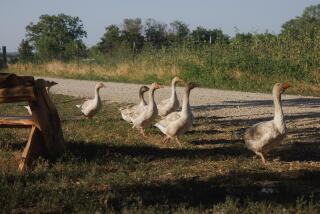The ‘Green Revolution’ : Farmers Plow Hard Row as Africans Restructure Economies
- Share via
NGIRESI, Tanzania — Why is the corn always greener--and taller, and plumper--on Loi Bangoti’s side?
Other farmers in the hills beneath cloud-capped Mt. Meru know the answer: Bangoti has joined the “green revolution.” His little acre is getting some big help.
“Before, I was harvesting no more than five bags of corn (1,000 pounds). Now I’m expecting more than 15 bags,” Bangoti said. “The others want to copy what I’m doing.”
They won’t be growing just corn. They’ll also be cultivating controversy.
For economists, scientists and aid officials, these lush, loamy hillsides of northern Tanzania have become a testing ground in a bloodless duel over policy that could mean more for Africa’s future than all its bloody ethnic wars.
Inspired by agricultural scientist Norman Borlaug, who won a Nobel Peace Prize for the “green revolution” of high-yield seed, fertilizer and irrigation that transformed Asian agriculture, a new generation of agronomists is trying to revolutionize farming in Africa.
But their use of government-subsidized seed and fertilizer is colliding with a counterrevolution in African economics.
The agronomists, active in five African nations, work for Sasakawa-Global 2000, or SG-2000--a joint development project of Japanese philanthropist Ryoichi Sasakawa and the Carter Center, former President Jimmy Carter’s organization in Atlanta. Borlaug is chairman.
Tanzania was targeted because, like Africa itself, it is a fertile land falling short of its potential. This crop year it has to import 300,000 tons of grain.
The agronomists, working with Agriculture Ministry extension agents, have sponsored 10,000 one-acre “management training plots” like Bangoti’s across Tanzania. Each plot is meant to be a model for the neighbors.
Through interest-free loans, the project supplies the model peasants with fertilizer and high-yield seed. The extension agents, equipped with vehicles by SG-2000, also advise the farmers on planting techniques and weed and insect control.
To an Iowa farmer, the methods are elementary. In Tanzania they are radical. Average fertilizer-per-acre use here is less than 10% of the U.S. level, and only one in 10 cornfields is planted with improved seed.
Success has been immediate: Corn yields have tripled or quadrupled.
“The farmers were amazed to see what could be done,” said Dixon Akyoo, secretary of Mbuguni, a nearby lowland village where 15 farmers are now buying high-yield seed and fertilizer on their own.
Bangoti’s hilltop acre is itself a “copycat” plot. The district council for Ngiresi, impressed with SG-2000 acreage, lent him the money for fertilizer and seed. “I’ll be able to pay off the loan and show a profit,” he said.
But the SG-2000 plots are an infinitesimal fraction of the 12 million Tanzanian acres planted with grain.
“We’re not big enough to make the system work ourselves,” acknowledged Abu M. Foster, senior scientist for the $1-million Tanzanian project. “But there are people who can. The job is to convince them.”
The “people” are the World Bank, the multibillion-dollar Washington institution that dominates Third World development. The bank has its own project, however.
Called “Training and Visit,” a $30-million effort in 31 African nations, it also sends agents to farms to instruct peasants, and it also establishes demonstration plots.
But the World Bank leaves out the “modern inputs”--hybrid seed and fertilizer.
“We’re looking for the right system, things that would increase production that don’t involve significant costs to the government for inputs,” World Bank official Ian Porter, former head of the bank’s Tanzanian office, explained in Washington.
Many development specialists believe “high-input” systems are unrealistically expensive for less-developed African nations. Instead, they advocate improving traditional agricultural methods.
In addition, promoting fertilizers would put the World Bank in an awkward position: Its economists have successfully pressured the Tanzanian government to begin reducing its subsidy for fertilizers, but the cost is still 55% subsidized.
The subsidy cuts are part of a “structural adjustment” liberalizing the formerly socialist economy. The free-market reforms, like those elsewhere in Africa, also include a phaseout of price controls and of the government corporation that bought farm produce.
In a country like Tanzania, burdened with weak transportation, credit and market systems, an abrupt withdrawal of government subsidies and institutions leaves a damaging vacuum, critics say. They say private institutions cannot quickly materialize to fill it.
Borlaug insists that Africa’s backward agriculture needs the jump-start of modern technology, and that governments must show the way.
“Development specialists from the First World nations must stop ‘romanticizing’ the virtues of traditional agriculture in the Third World,” said the 1970 Nobel laureate, who now teaches at Texas A & M University.
Even some who promote structural adjustment programs, like U.N. economist Richard J. Perkins, are uneasy over what they mean for future food supplies.
“One has to safeguard agricultural production,” said Perkins, a top official of the Food and Agriculture Organization in Rome. “One has to be careful with fertilizer subsidies, with abolishing institutions.”
It will take years and billions of dollars, but Perkins’ FAO, the World Bank, Borlaug’s SG-2000 and other development agencies will continue to search for the right way to close the “1% gap”--the lag of African food production.
More to Read
Sign up for Essential California
The most important California stories and recommendations in your inbox every morning.
You may occasionally receive promotional content from the Los Angeles Times.













